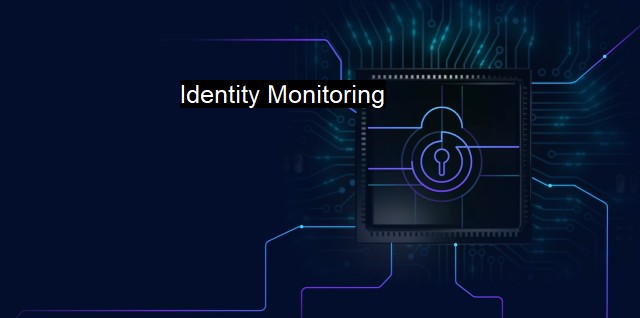What is Identity Monitoring?
Why Identity Monitoring is Crucial for Cybersecurity in the Digital Age: Protecting Personal and Financial Data from Cyber Attacks and Identity Theft
Identity monitoring forms a crucial part of cybersecurity practices, earmarked by the constant scrutiny of personal or business identities to pick up activities that may hint at theft or misuse. By monitoring signifiers of identity, which could range from Social Security numbers to details provided for credit card applications, safeguards can be applied to ensure that personal identities aren't appropriated unlawfully. As identity theft threats continue to grow, these vigilant practices– especially in the online space– become increasingly necessary.In the context of cybersecurity and antivirus solutions, identity monitoring provides an added shield against potentially devastating cyber-attacks by flagging unauthorized use of an individual's or business's personal details. Cybercriminals, armed with increasingly sophisticated tools and techniques, seek to harness personal identifiers typically to perpetrate fraud or breach secure environments.
Cybersecurity techniques like biometric identification, two-factor authentication, password encryption are instrumental in protecting digital identities. exposure to bugs, software vulnerabilities, unchecked downloads, or cloned sites could undermine these measures, hence the need for identity monitoring.
Identity monitoring tools primarily scour databases, credit bureaus, websites dark web, as well as other sources, for matching or incorrect use of data identifiers, subject to one's permission. By casting a broad and vigilant net across multiple platforms, fraudulent actions can be detected, allowing individuals and organizations to take move quickly upon detection.
To contextualize this monitoring could include several scenarios. For instance, an alert may be generated if someone tries to apply for credit using your identification, significantly mitigating the potential for damage. The practice essentially allows organizations or individuals to act speedily against transgressions.
The scope of identity monitoring also extends to public records, black market websites, and even chat rooms where stolen identities may be traded or sold. Unscheduled credit file changes, unexpected utility services, court or arrest records, unfamiliar credit card purchases, loan applications, or unusual policy changes – to various extents – all warrant alerts that can be acted on.
Today's identity monitoring solutions extend far beyond merely following one's financial footprint. They encompass complex mechanisms that delve into several online databases and archives to ensure comprehensive monitoring covering any possibility of identity theft.
An apt metaphor for this could be perceived as internet bodyguards surveilling the virtual terrain that different identifiers have been shared, sold, or indeed misused. These identifiers can range from more personal details like home addresses and passport numbers to digital oriented data such as IP addresses and numerous other digital footprints.
Such systems' regular technological updates ensure they stay on top of ever-evolving identity theft methods, confirming your protective measures evolve as fast, if not faster, than the threats that they’re constructed to counteract.
Internet users should be cognizant in complementing identity monitoring coverage with preventive behavior, including wisely sharing personal identifiers while online and regularly updating software to shield from vulnerabilities.
Further, employing antivirus solutions, frequently updating security patches, and firewall domesticate safe digital environments where identity theft and misuse find it hard to thrive. These practices, in tandem with identity monitoring solutions, keep identity theft threats at bay and ensure an individual's or an organization’s identifiers stay confidential.
While guaranteeing absolute security can never be foolproof, identity monitoring substantially contributes towards achieving it, helping safeguard against unauthorized attempts to victimize individuals or compromise businesses. With sound identity management and monitoring solutions, cyber safety mechanisms can mitigate potential damage and contribute substantially towards beefing up online territory's security.

Identity Monitoring FAQs
What is identity monitoring?
Identity monitoring is a cybersecurity service that monitors and alerts you about any suspicious activity related to your personal information, such as your social security number, credit card numbers, and address. It helps you detect identity theft and fraud early on so that you can take corrective actions.What are the benefits of identity monitoring?
Identity monitoring offers several benefits, such as early detection of identity theft, reduced financial losses, and protection of your credit score. It also gives you peace of mind knowing that your personal information is being monitored by experts.How does identity monitoring work?
Identity monitoring works by scanning various sources, such as the dark web, public records, and financial transactions, to detect any suspicious activity related to your personal information. If any such activity is detected, you will receive an alert, and the monitoring service will provide guidance on what steps to take next.Is identity monitoring the same as antivirus software?
No, identity monitoring is not the same as antivirus software. While antivirus software protects your device from malware, ransomware, and other viruses, identity monitoring specifically focuses on monitoring your personal information for any signs of identity theft or fraud. However, some antivirus software may offer additional identity monitoring features as part of their service.| | A | | | B | | | C | | | D | | | E | | | F | | | G | | | H | | | I | | | J | | | K | | | L | | | M | |
| | N | | | O | | | P | | | Q | | | R | | | S | | | T | | | U | | | V | | | W | | | X | | | Y | | | Z | |
| | 1 | | | 2 | | | 3 | | | 4 | | | 7 | | | 8 | | |||||||